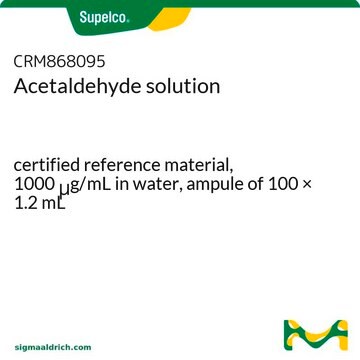W200360
Acetaldehyde
≥99%, meets FCC analytical specification
Synonym(s):
Ethanal
About This Item
Recommended Products
biological source
synthetic
Quality Level
grade
Kosher
Agency
meets purity specifications of JECFA
reg. compliance
meets FCC analytical specification
vapor density
1.52 (vs air)
vapor pressure
14.63 psi ( 20 °C)
Assay
≥99%
form
liquid
autoignition temp.
365 °F
expl. lim.
60 %
refractive index
n20/D 1.332 (lit.)
pH
5 (20 °C)
bp
21 °C (lit.)
mp
−125 °C (lit.)
density
0.785 g/mL at 25 °C (lit.)
application(s)
flavors and fragrances
Documentation
see Safety & Documentation for available documents
food allergen
no known allergens
Organoleptic
fruity; pungent; ethereal
storage temp.
2-8°C
SMILES string
CC=O
InChI
1S/C2H4O/c1-2-3/h2H,1H3
InChI key
IKHGUXGNUITLKF-UHFFFAOYSA-N
Looking for similar products? Visit Product Comparison Guide
Related Categories
Packaging
Legal Information
Disclaimer
Signal Word
Danger
Hazard Statements
Precautionary Statements
Hazard Classifications
Carc. 1B - Eye Irrit. 2 - Flam. Liq. 1 - Muta. 2 - STOT SE 3
Target Organs
Respiratory system
Storage Class Code
3 - Flammable liquids
WGK
WGK 3
Flash Point(F)
-38.0 °F - closed cup
Flash Point(C)
-38.89 °C - closed cup
Personal Protective Equipment
Certificates of Analysis (COA)
Search for Certificates of Analysis (COA) by entering the products Lot/Batch Number. Lot and Batch Numbers can be found on a product’s label following the words ‘Lot’ or ‘Batch’.
Already Own This Product?
Find documentation for the products that you have recently purchased in the Document Library.
Customers Also Viewed
Our team of scientists has experience in all areas of research including Life Science, Material Science, Chemical Synthesis, Chromatography, Analytical and many others.
Contact Technical Service




